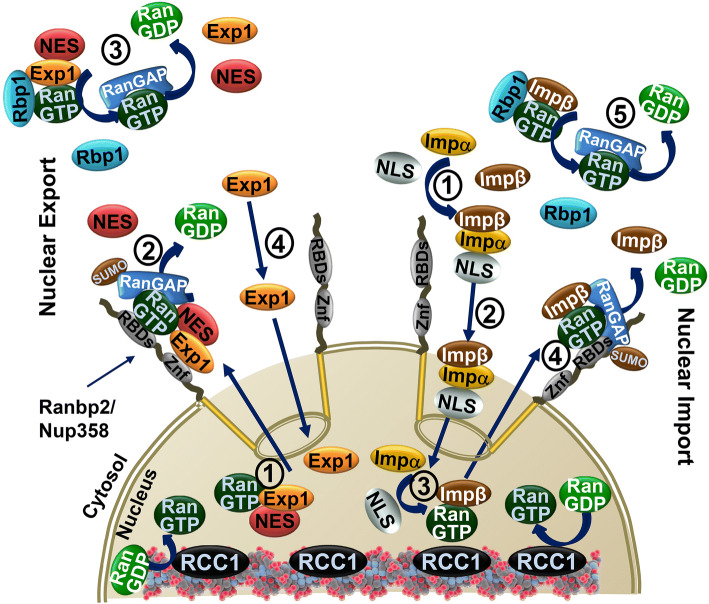Fig. 2.
Nuclear export and import of protein substrates. Nuclear export (left) of proteins is mediated by nuclear export receptors, exportins, such as exportin-1 (Exp1), which recognizes cargoes containing nuclear export sequences (NES). Cooperative association of exportin-1, Ran-GTP and NES-containing substrates promotes the nuclear export of nuclear cargo ensembles (1). Disassembly of nuclear export ensembles occurs when they encounter Ran-binding protein 2 (Ranbp2; a.k.a. Nup358) (2), which forms the cytoplasmic filaments of the nuclear pore, or Ranbp1 in the cytosol (3). Ranbp2 has a domain with zinc-finger motifs (ZnF), which binds exportin-1, and four Ran-GTP-binding domains (RBDs; only a single domain is represented). Ranbp1 has a single Ran-GTP-binding domain. The RBDs of Ranp2 and Ranbp1 destabilize Ran-GTP from its cargo ensemble and promotes the hydrolysis of Ran-GTP by RanGAP in the cytosol or by SUMOylated RanGAP (SUMO-RanGAP) at Ranbp2. Finally, free exportin-1 (Exp1) diffuses back to the nuclear compartment (4). Nuclear import (right) of proteins is mediated by the nuclear import receptors, importins, such as importin-β (Impβ), or its adaptors, such as importin-α (Impα), which recognizes cargoes containing nuclear localization sequences (NLS) (1). Nuclear import ensembles are transported to the nucleus (2), where they are disassembled upon encountering a high concentration of Ran-GTP, which binds to importin-β (Impβ) (3). Importin-β (Impβ)-bound to Ran-GTP is recycled back to the cytoplasm, where it is released from Ran-GTP by the RBDs of Ranbp2 (4) or Ranbp1 (5). RanGAP in the cytosol and SUMOylated RanGAP (SUMO-RanGAP) at Ranbp2 promote the hydrolysis of Ran-GTP

